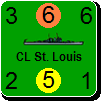Joel Billings
Posts: 32265
Joined: 9/20/2000
From: Santa Rosa, CA
Status: offline

|
quote:
ORIGINAL: color
quote:
ORIGINAL: Joel Billings
(c) (Section 22.3.2) The percent of damaged elements has been reduced in December 41 so instead of roughly 5-20% the losses are now roughly 1-7% (the damage losses are still reduced by 50% in Jan/Feb 1942).
Thanks a lot for sharing these details 
There's one thing that jumped to my eye, so I'm curious about knowing a little about the changing interactions in the game engine.
Above statement says blizzard attrition is going from 5-20% damaged to 1-7%, is that correct?
At first sight seems like a big change that will considerably lower german blizzard attrition losses.
Upon reading some other details in your list I get the impression you are tweaking other parts of the engine.
Does that in effect mean some parts of the losses previous suffered from blizzard, are now suffered in general ?
Trying to rephrase the above statement: even though that drop in blizzard damaged % is large, it's deceiving in an isolated context as losses are generally going to be higher due to other attrition factors?
I'm especifically thinking about:
- 10) More damaged units returned to pool are disabled resulting in less % damaged units recovered.
- 12) increased front line attrition & KIA % with net change resulting in more damaged elements
I do not intend to critize, I'm merely analyzing the changes trying to understand what impact the changes will generate.
Good questions. Let me start by saying a few things about how I view the state of the game in 1.03.
I feel the game is fun to play and that many/most of the smaller scenarios are balanced fairly well. As for the Grand Campaign I believe there is truth in both the German supermen and the Soviet supermen in blizzard. The German supermen has truth in that an expert German player can defeat a weaker Soviet player by keeping them off balance and destroying lots of Soviet units and taking key locations. This leads to either a break in the Soviet morale, or a very bad situation for the Soviets even after the blizzard (it doesn't usually get that far as the Soviet player morale breaks). There is truth to the Soviet supermen in blizzard because the average Soviet player is able to take back too much territory and the Germans are hurt too badly during blizzard. There is also truth to the fact that the Germans are too strong going into the blizzard. One reason why the blizzard is so bad is because the Germans were found to be too strong after the blizzard if the blizzard wasn't strong enough. What I don't know for sure is what an expert German would do against an expert Soviet player, because expert German players can do so well in 41 to be able to endure the winter, but against and expert Soviet they might find themselves right where average German players usually find themselves (beaten badly in the blizzard).
After studying things further, we found that the Germans were in fact too strong going into the blizzard and the Soviets were also usually too strong (even when they took "historical" casualties). So we had a goal of fixing this as well as trying to improve the blizzard so it would not be harsh as it has been because it clearly was too harsh. This is where we were as we were moving into 1.04 work. Around this time we discovered several anomalies with manpower that we had never noticed before. It was clear in order to get a handle on what should change we needed to make sure everything was working as expected. Pavel made a thorough review of how manpower was flowing and found and fixed several major bugs with manpower. These are on the 1.04 bug fix list. Many of these bugs were impacting both players, but several impacted only one, or one player more than the other. The net effect of these manpower bugs was that both sides were not losing manpower that should have been lost (due to withdrawals, various kinds of losses not being accounted for correctly, etc.). It was clear that we needed to fix these first so we could feel confident that we were working with a stable system before making changes. Ideally these would have been found and fixed pre release, but once we knew about them we had to get them fixed. This part is done now, and the system seems to be working well. The net impact of all of these fixes is very hard to figure out. We can run AI vs AI tests but human vs human tests can take weeks.
So with the bugs fixed we now looked to try to find out what was wrong with the model. What we concluded was that we were not accounting for enough time for casualties to be out of action. We have two ways to deal with non-destroyed manpower. First, the damage system which makes them unavailable for combat and over time fixes some and sends others back to the pool (with some becoming disabled). Second was the disabled system that takes a percentage of these damaged elements going to the pool and puts them in the category of more seriously wounded and thus out of action for a much longer time period. During normal times, the damaged system was repairing many of the elements quickly, and those returning to the pool were immediately available to return to the front (with only a small portion disabled). We think this system was not taking enough men out of action for long enough periods of time. There was a catch though in blizzard. During the first winter the German supply situation is so bad (as it should be) that the damaged elements were often being destroyed outright, or creating a huge churn of men from the front back to the pool, both causing larger disabled numbers. The large frostbite damaging of squads was a major cause of damaged churn as well. Now there should be more disabled during the winter due to sickness/frostbite, and the compounding effect of combat and life in weather the Germans were not used to. However, it was too much and combined with the CV reductions and the larger Soviet armies facing them, the Germans were being forced back too much.
We could have tried to alter one or two formulas, but since there were some systemic problems, it seemed better to try to make changes in many places. In addition we had already wanted to make changes to fort levels based on what we had been seeing, so that and several other changes and bug fixes were thrown into the mix as well. In the end we hope to have a better system that is more consistent and fitting reality. For example we were finding later on that manpower totals for both sides, especially the Soviets were higher than we thought they should be. In looking at casualty numbers it became clear that large numbers of soldiers that were not killed or captured were eventually discharged or sent to duties that would not show up in the game. Given our current mechanism, the disabled pool has to account for this.
As for your specific questions, the frostbite percentage didn’t make sense anymore (if it ever did) given that we increased the percent disabled for damaged troops returning to the pool. While we brought this number down, we found that the number of disabled was still very large, and we think this is because of the terrible supply situation the Germans are usually in during the blizzard. We looked at our supply modifier during blizzard and thought it was too harsh, so we adjusted this. We needed to increase the percent of damaged troops returning to the pool that are disabled given the casualty out of action time I talked about above. We also created the concept of a “transit pool” to deal with manpower that recovers fairly quickly but still needs a some time off to account for the time the individual is away from the front. Given all the changes, we also took the time to better rationalize the attrition split between killed and disabled men.
Now, did we get it all right? Of course not. It would be foolish of me to think that we’ve got everything working just right. There are many posts in the tester forum regarding concerns one way or the other about some of the changes (some by me). AI vs AI tests which can be done quickly only tell us so much. Human vs AI and Human vs Human tests take much longer. We do think things are moving in the right direction, but realistically getting things to balance out right is going to take time, and this will need to include public beta time. For all its faults, we still think that 1.03 is a good game and can be enjoyed as is. Games started with 1.03 can be continued with 1.04 if players want to do this, but the effects of all the changes on balance in these games are impossible to determine. For those of you playing tournaments or serious matches where you are playing both sides and combining scores, I suggest you not switch versions during your two-game matches. We appreciate the support of the community in helping to make this a better product, especially those willing to play and comment on beta versions knowing that their beta games may experience some turbulence.
_____________________________
All understanding comes after the fact.
-- Soren Kierkegaard
|
 Printable Version
Printable Version





















 New Messages
New Messages No New Messages
No New Messages Hot Topic w/ New Messages
Hot Topic w/ New Messages Hot Topic w/o New Messages
Hot Topic w/o New Messages Locked w/ New Messages
Locked w/ New Messages Locked w/o New Messages
Locked w/o New Messages Post New Thread
Post New Thread